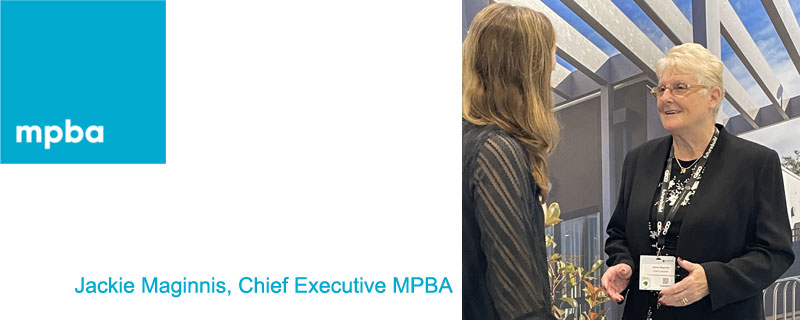As the industry looks to address the gender imbalance, Jackie Maginnis was certainly ahead of her time not only as a high-profile woman in construction but also in promoting the benefits of advanced building technologies. With a long and illustrious career, more recently in the modular and portable building industry, for over 50 years she has been involved in construction related businesses.
Starting her working life at SGB (Scaffolding Great Britain) in the Plant Hire Division, later transferring to SGB Rovacabin (the hire division now part of Wernick Group), Jackie held various positions from Northern Regional Manager to National Operations Manager and everything in between. It was her work involving the product design and development of modular buildings that caught the attention of the Modular and Portable Building Association (MPBA) and in 2005 she was invited to join and take up the position of Chief Executive – a role she still holds today.
With a mission to develop a wider understanding of what can be achieved using volumetric modular construction, Jackie gives credit to the public sector.
“As an early adopter of modern methods of construction (MMC), councils and local authorities were using volumetric modular technology across all sectors in the 70’s and 80’s particularly to cope with a rapid increase in the need for education buildings as a result of the post war baby boom. This was very much the development ground for MMC – backed by thinking way ahead of its time.”
“We cannot yet claim to be ‘mainstream’, but we have seen a dramatic uptake in volumetric modular technology which is now considered as category one in the MMC Frameworks,” said Jackie. “The support for government projects, particularly in healthcare and education, has come from lobbying over the years from the MPBA and our members, to get specification and procurement changes in place. In the wake of more backing from Westminster, we have witnessed an increase in investment and modular construction frameworks across all public sector projects.”
Jackie states that as the industry association, the MPBA has a mission to educate and dispel misconceptions and highlights an example.
“A few years ago, there was a mistaken belief that a volumetric approach stifles design capabilities. But then new architects came to the fore that not only embraced modern methods of construction but proved without doubt the design potential of modular technology.”
Jackie agrees that we have since moved on and most understand the predictability, productivity, quality and safety gains achieved in volumetric manufactured buildings. But when asked if she had any frustrations, Jackie said:
“As ever ‘the devil is in the detail’ and there is still an element of confusion particularly in some areas of government and wider trade bodies which is naturally causing some disconcert within the MPBA fraternity.
“This is predominately driven by a lack of understanding of the different requirements between the modular commercial and residential sectors. Policy is being dictated by the perceived growth in residential markets and then applied to the mature commercial sector – the pitfalls surrounding this approach are obvious. Then there are the global markets, particularly in the US and EU where construction methods are totally different and we cannot apply the same protocols as the UK, which is a world leader in not only volumetric modular technology but building standards.
“The term ‘modern methods of construction’ was reintroduced in 2019 by Communities and Local Government following a specific commitment made in the 2017 white paper fix our broken housing. The MMC Framework that followed as a result was specifically written for large scale housing projects but has been continually implemented across the wider non-domestic sectors where modular construction techniques have matured over several years. There are significant differences in the supply chain, design factors, risk profiles and significantly, terminology used. The MPBA has released a Non-domestic Guide to Modern Methods of Construction Categories to raise awareness.”
“Modular construction quite rightly has to conform to Building Regulations, so for example, combustible materials have been banned for use on the external walls of new buildings of at least 18 metres containing one or more dwellings since 2018. To our dismay a brochure promoting a trade body in the building safety arena, has an image of a timber module being craned onto about the tenth storey. Clearly not a UK development, but this lack of attention to detail, particularly by those who are involved in setting the standards, is disappointing to say the least.”
After all these years in the industry, Jackie is still totally committed and fiercely passionate about representing the MPBA and its members. But when asked ‘what’s next’ Jackie said: “We need to ensure policy decisions are evidence based for the good of not only the modular industry and the wider construction sector but most importantly to ensure the best outcomes for building owners and occupiers. There is still much work to be done, so I intend to continue on my mission to promote modular for some time to come!”
MPBA
The MPBA plays a key role in the connecting of sectors in the modular and portable building industry. The association collaborates with specialist technical advisors to enhance innovation in the design and manufacture of volumetric modular buildings. These can be designed and manufactured from timber or steel in any size and shape to meet individual client needs while ensuring full compliance with building regulations.
To discover how volumetric modular technology can benefit construction projects visit: www.mpba.biz





Leave a Reply
Want to join the discussion?Feel free to contribute!